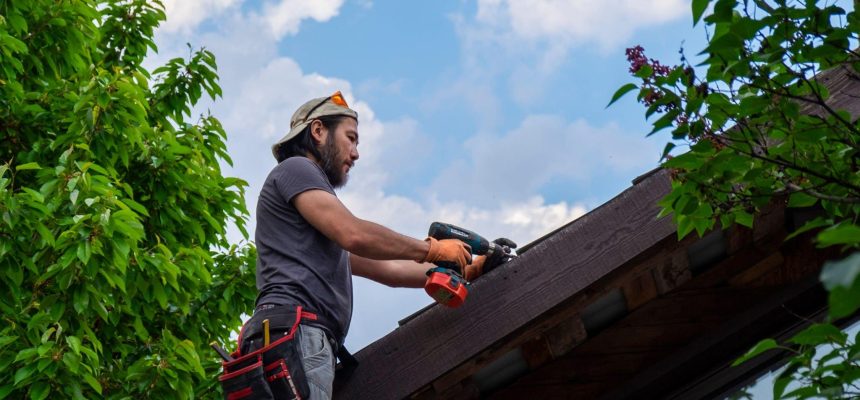Understanding the lifecycle of your roof is pivotal in maintaining the safety, efficiency, and aesthetics of your home. A roof doesn’t just shelter you from the elements; it’s a significant investment in your property’s value and integrity. However, homeowners often find themselves at a crossroads, faced with a critical decision: should a roof be repaired or entirely replaced? This decision can be complex, involving factors like the roof’s age, the extent of damage, and the costs involved.
In this comprehensive guide, we delve into the nuanced journey of a roof’s lifecycle. From initial installation to the inevitable wear and tear, we’ll explore the signs that dictate whether a simple repair will suffice or if a full replacement is necessary. By understanding these key indicators and considering expert advice, you can make informed decisions that ensure the longevity and reliability of your roof. As specialists in residential roofing, A & J Reliable is here to guide you through this process, offering insights rooted in years of experience across New York, New Jersey, and Connecticut.

Understanding the Roof Lifecycle
The concept of a roof’s lifecycle is integral to grasping the needs and demands of your home’s roofing system. Just like any other component of your home, a roof undergoes a journey from its installation to the end of its useful life. This journey is shaped by various factors that can either shorten or extend its lifespan.
Material Matters: The type of material used plays a pivotal role in determining the lifespan of a roof. For instance, asphalt shingles, popular for their affordability and ease of installation, typically last between 15 to 30 years. On the other hand, more durable materials like metal, tile, or slate can last 50 years or more, offering a longer-term but often more expensive solution.
Impact of Climate: The environment in which your home is located also significantly affects your roof’s lifespan. In areas like New York, New Jersey, and Connecticut, where A & J Reliable predominantly operates, roofs are subjected to a variety of weather conditions – from heavy snowfalls in winter to humid summers. Such diverse weather patterns can accelerate wear and tear, making regular maintenance even more crucial.
The Role of Maintenance: Regular maintenance is key to maximizing your roof’s lifespan. Simple actions, such as cleaning gutters, removing debris, and conducting routine inspections, can prevent minor issues from becoming major problems. Neglect, on the other hand, can lead to premature deterioration and costly repairs.
Aging and Wear: Over time, all roofs show signs of aging. Exposure to elements like sun, rain, and wind gradually wears down roofing materials. This natural wear can lead to common issues such as leaks, loose or missing shingles, and weakened structural integrity.
By understanding these aspects of a roof’s lifecycle, homeowners can better anticipate the needs of their roofs. Regular assessments by roofing experts, like those at A & J Reliable, are invaluable in this process, helping you to identify potential issues early and make informed decisions about repair or replacement.
In the next sections, we will delve into the signs that indicate when a repair might be sufficient and when a full replacement is advisable.
Signs of Wear and Tear
Identifying the signs of wear and tear on your roof is crucial in determining whether it’s time for a repair or a complete replacement. Regularly monitoring these indicators can save you from unexpected costs and ensure your roof remains in optimal condition. Here are some common signs to look out for:
Missing or Damaged Shingles: One of the most obvious signs of wear is missing or visibly damaged shingles. Shingles that are cracked, curled, or missing entirely expose your roof to water infiltration and other environmental damages. This kind of wear often indicates the need for repairs or, in severe cases, a complete roof overhaul.
Water Leaks and Ceiling Stains: If you notice water stains on your ceilings or walls, it’s a clear indicator that your roof is leaking. These leaks can lead to more significant issues, like mold growth and structural damage, if not addressed promptly.
Granules in the Gutters: Asphalt shingles shed granules over time, especially as they age. If you start to find excessive granule accumulation in your gutters, it could signify that your shingles are nearing the end of their lifespan.
Sagging Roof Deck: A sagging roof deck is often a symptom of a more serious structural issue. It can be caused by long-term exposure to moisture or inadequate support. This kind of damage typically requires immediate professional attention.
Sunlight Through the Roof Boards: If you can see sunlight through the boards in your attic, it’s a definite sign that your roof is compromised. This can be an indication of significant damage that might necessitate a roof replacement.
Rising Energy Bills: An increase in your energy bills could be linked to poor roof insulation or ventilation. A well-maintained roof plays a key role in regulating your home’s temperature and energy efficiency.
By staying vigilant to these signs, you can address roofing issues before they escalate into larger problems. Remember, early detection and timely intervention by professionals like A & J Reliable can prolong the life of your roof and ensure your home’s safety and comfort.
In the following sections, we will explore the specific scenarios where a repair might suffice and when it would be wise to invest in a new roof.
When to Repair Your Roof
Understanding when a repair is sufficient can save homeowners time and money while maintaining the integrity of their roof. Not all signs of wear necessitate a full replacement. Here are scenarios where a repair might be the most appropriate course of action:
Minor Leaks: Small leaks can often be fixed without the need for a complete roof overhaul. These are usually localized issues that, when addressed promptly, can be repaired effectively.
Partial Damage: If the damage to your roof is confined to a small area – perhaps due to fallen branches or wind damage – it’s often possible to replace just the affected shingles or roofing materials. This localized approach can extend the overall life of your roof without the cost of a full replacement.
Recent Installation: If your roof is relatively new, minor issues are likely to be repairable. A roof that’s only a few years old and has been well-maintained should not need to be replaced entirely due to minor damage.
Budget Constraints: For homeowners facing budget constraints, repairing critical areas of the roof can be a cost-effective solution. While this is a short-term fix, it can buy time until a full replacement is feasible.
Maintaining Roof Integrity: Regular maintenance can often catch and resolve minor issues like replacing worn-out flashing or sealing leaks around chimneys and vents. These small repairs are crucial in maintaining the overall health of your roof.
It’s essential to consult with roofing professionals like A & J Reliable to accurately assess the condition of your roof. They can provide expert advice on whether a repair is sufficient or if more extensive work is required. Quick and efficient repairs not only solve immediate problems but also help in preserving your roof’s condition for the future.
In the next section, we’ll discuss the circumstances under which a full roof replacement is recommended.

When to Replace Your Roof
There are circumstances where repairing your roof is no longer a viable option, and a full replacement becomes necessary. Understanding these scenarios can help you make informed decisions about your home’s roofing needs. Here are key situations when you should consider replacing your roof:
Age of the Roof: The age of your roof is a primary indicator. If your roof is nearing or has surpassed its expected lifespan (20-30 years for asphalt shingles, for example), it might be time for a replacement. Older roofs are more prone to leaks and other issues that compromise their effectiveness and safety.
Extensive Damage: When a significant portion of your roof is damaged, either by severe weather events, fallen trees, or long-term wear and tear, repairs might not be enough. Extensive damage often means that a roof’s structural integrity is compromised, making replacement the safer and more economical long-term choice.
Major Leaks and Water Damage: If your roof has multiple leaks or has sustained major water damage, a simple repair might not suffice. Water damage can lead to mold, rot, and structural issues that are best addressed by a full roof replacement.
Roof Sagging: A sagging roof is a serious issue that often indicates structural problems. This could be due to long-term water damage, poor roof installation, or inadequate support. In such cases, a full roof replacement is necessary to prevent potential collapse.
Inefficient Energy Performance: An old or poorly performing roof can significantly impact your home’s energy efficiency. If you notice a steady increase in heating or cooling costs, it might be due to your roof’s inability to properly insulate your home. Replacing your roof can improve energy efficiency and reduce your utility bills.
Renovation or Home Value Increase: If you’re renovating your home or looking to increase its market value, a new roof can be a significant selling point. A new roof not only improves the aesthetic appeal of your house but also reassures potential buyers about the home’s condition.
Remember, a roof replacement is a considerable investment, but it can offer peace of mind, enhanced safety, and long-term savings. Consulting with roofing experts like A & J Reliable can provide you with a comprehensive evaluation of your roof’s condition and help you decide whether replacement is the best option for your home.
In the following section, we will compare the costs involved in roof repair versus replacement, helping you navigate these financial considerations.
Comparing Costs: Repair vs. Replace
When faced with roofing issues, homeowners must consider the financial implications of repairing versus replacing their roof. Understanding these cost dynamics can help in making a decision that aligns with both your budget and your home’s long-term needs.
Repair Costs: Repairs are generally less expensive in the short term. The cost of a repair depends on the extent of the damage and the materials required. Minor fixes, such as replacing a few shingles or sealing a small leak, can be relatively affordable. However, frequent repairs can add up over time, especially if the underlying issues are not fully addressed.
Replacement Costs: A roof replacement is a significant investment, but it’s important to consider the long-term benefits. A new roof can increase your home’s value, improve energy efficiency, and eliminate the need for frequent repairs. The cost of replacement varies depending on the size of your roof, the materials chosen, and labor costs. While the initial outlay is higher, a new roof typically offers a more cost-effective solution over the long term.
Cost-Benefit Analysis: When deciding between repair and replacement, consider the age and current condition of your roof. If your roof is relatively new and the damage is minimal, repair might be the most economical choice. However, if your roof is nearing the end of its lifespan or has significant damage, investing in a new roof could be more prudent financially. A new roof can also provide peace of mind, knowing that your home is well-protected for years to come.
Financing and Insurance Considerations: It’s also worth exploring financing options and insurance coverage. Some roofing companies, like A & J Reliable, offer financing plans to help manage the cost of a roof replacement. Additionally, if the damage is due to a covered event like a storm, your homeowner’s insurance might cover some of the replacement cost.
Ultimately, the decision to repair or replace your roof should be based on a thorough evaluation of both immediate costs and long-term value. Consulting with roofing professionals can give you a clearer understanding of the costs involved and the best course of action for your specific situation.
In the next section, we’ll discuss the importance of expert roof inspection in guiding these decisions.

Expert Roof Inspection: The Key to Decision Making
When it comes to deciding whether to repair or replace your roof, the expertise of a professional roof inspection cannot be overstated. A thorough inspection by knowledgeable professionals, like those at A & J Reliable, is crucial in accurately assessing the condition of your roof and guiding your decision-making process.
Comprehensive Assessment: A professional roof inspection goes beyond a mere surface evaluation. It involves a detailed examination of both the exterior and interior aspects of the roof. Inspectors look for signs of wear and tear, structural issues, water damage, and potential vulnerabilities that might not be visible to the untrained eye.
Identifying Underlying Issues: Expert inspectors can identify underlying problems that could lead to more significant issues in the future. For instance, a small leak might seem like a minor issue, but it could be indicative of more extensive damage beneath the shingles.
Personalized Recommendations: Based on the inspection findings, roofing professionals can provide personalized recommendations. They will consider factors such as the age of your roof, the extent of the damage, and your budget to suggest the most appropriate course of action – whether it’s a targeted repair or a full replacement.
Safety and Compliance: Professional inspectors also ensure that your roof complies with building codes and safety standards. This is particularly important in areas with specific regulations, like those in New York, New Jersey, and Connecticut, where A & J Reliable operates.
Future Planning: An inspection can also help in future-proofing your roof. Professionals can advise on maintenance practices and improvements to extend the life of your roof, whether you decide to repair or replace it.
By opting for a professional roof inspection, you gain clarity and confidence in your decision. It’s an investment in the health of your home that can save you time, money, and stress in the long run.
In the next section, we will introduce A & J Reliable’s range of roofing services and their commitment to guiding homeowners through these important decisions.
Conclusion
As we’ve explored in this guide, understanding the lifecycle of your roof is key to maintaining your home’s safety and aesthetic appeal. Whether it’s through timely repairs or a necessary replacement, taking the right steps at the right time can significantly impact the longevity and performance of your roof. Recognizing the signs of wear and tear, and understanding when to opt for repairs or a replacement, are essential in making informed decisions for your home.
At A & J Reliable, we are committed to providing you with the expertise and services needed to navigate these decisions. Our team of professionals is equipped to assess, advise, and act on all your roofing needs, ensuring that your roof remains a reliable shield for your home.
Schedule a free roof inspection with us today. Our skilled professionals will provide a comprehensive evaluation of your roof and guide you through the decision-making process, ensuring that you choose the best option for your home. Visit us at Free Roof Inspections to book your inspection.





